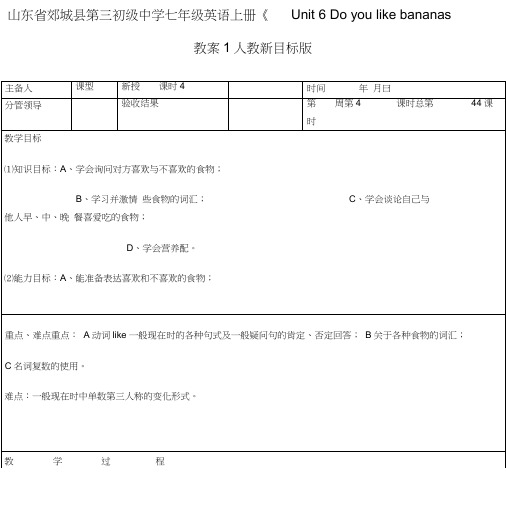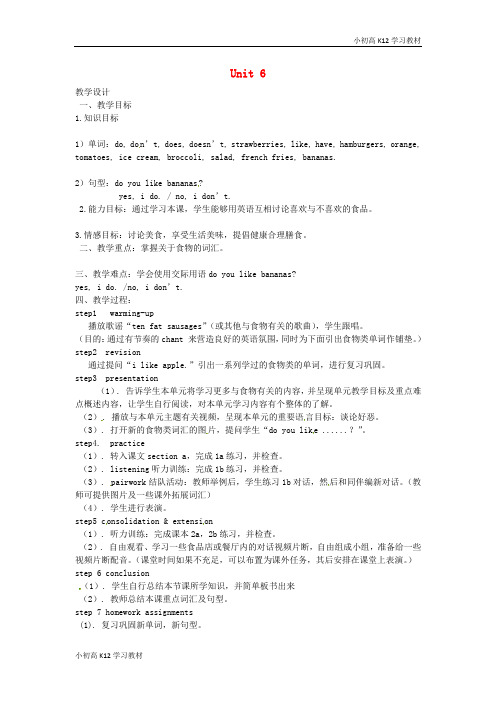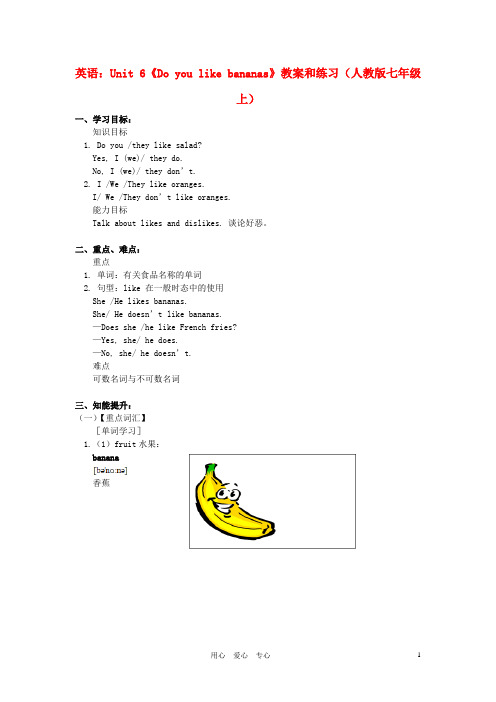最新七年级英语上册Unit6Doyoulikebananas学案1 人教新目标版
- 格式:doc
- 大小:155.00 KB
- 文档页数:6

Review of Unit 6 Do you like bananas? 第一部分:基础知识梳理Part 1:重点单词同步检测:1.1 have hamburgers for b2.Here are some tomatoes.Do you like t3.1 like French f1.1have some ice c5.Children should(应当)eat lots of v6. What do you have for d?7.Zhou Jielun is a singing s8.She eats h food every day.Part 2:根据汉语或英语提示翻译下列短语1. 一个苹果/蛋2. 两个汉堡包3. 一些西红柿11.所有的蔬菜12.体育明星13.吃得好4 . 一些牛奶/沙拉5 .许多草莓6 .许多面包7 . 一些牛奶/沙拉8 .许多草莓9 .许多面包14 .她的饮食习惯15 .吃早/午/晚餐16 .作为早/午/晚餐17 .健康的食物.最后一个问题 18 .问某人有关某事.想要做某事 想要某人做某事同步检测:Everyone knows 1.is very important for our health. If you 2. eat healthily, the following tips (提示) may be helpful to you.Firstly, 3.the food you should eat. Do you4. 5. meat? We can have some fish, chicken and pork (猪肉)every day, but we should not eat too much meat. Besides, don't eat ice-cream a lot, or you will 6.. Secondly, you should have a good 7.. When you 8.a sports star his habits in eating, he may tell you to have many kinds of food every day. It is not good to 9.too much food. You may find it difficult to fall asleep (睡着).10.pay attention to (注意)our eating and have a healthy body.书面表达你有健康的饮食习惯吗?假设你是David,下面是你总结的自己的三餐喜好,请 根据表格内容写一篇短文,介绍你自己的饮食习惯。

山东省郊城县第三初级中学七年级英语上册《Unit 6 Do you like bananas教案1人教新目标版healthy, unhealthy.T: Look at these pictures. (Show thes e pictures of dessert.)dessert.Step Two: Task.T: Now look at the pictures of these foods. (Show some food pictures.) What kind of food do you think are healthy or unhealthy? Discuss in four people and fil I in the chart. (Each group will have a chart)T: So we eat more healthy food and less unhealthy food ・ Healthy food is good for our health, but unhealthy food is bad for our health. They are all dessert. In Chinese it means甜食 \We often eat it after the important dishes.T: Read after me, dessert, D-E-S-S-E-R-T, Ss: dessert. D-E-S-S-E-R-T, Healthy food Un healthy foodS: , are healthy food, are unhealthy food ・ (Ask some groups to report.)Step Three: Learn to write about what somebody likes for three meals・①Read the passage.T: Look at Liu Xiang ! Do you know why he is very healthy?T: Yes, he really eats very well. Every player just eats healthy food. Three is another running star. Her name is Sandra Dlark. Let 's s ee what she likes eating for three meals. Openyour books and read 3a(The students read the passage and fill in the chart, then check the answers.)T: Sandra Clark has a brother, Tom. He is very clever, but a little naughty. Lookat 3b and find out what Tom likes for breakfast, lunch and dinner. Complete the following passage ・ (The students do 3b and check the an swers.)②Practice. S: Fr uits,S: Four lunch ,T: I like eggs and milk for breakfast.What do you like eating for breakfast?(Point to a student)T: What about you? (Point to another student)T: Who can ask and answer like this?one.) S: I like apples andbread.S: I like hamburgers and bananas.( Ask two more stude nts to an swerhis/her questions for lunch and dinner.)What do you like to eat for lunch? Sa:Sb: I like ,Sa: What do you like toStep Four: Task・①Write a passage about you like for three meals.T: Can you introduce yourself for three meals according to what you talked about just now? Maybe many friends want to know you. (The students write about themselves as quickly as they can. When they are ready, ask them to introduce.)②Make a survey about your classmates for th re e meals.T: Do you have any friends? (Ask a stude nt.)T: Do you know what they like eating for each meal?T: OK. Let ask our friendsand try to know what they like. Then fill in the chart.Sb: I like ,(Then ask the students to work in pairs one byS: Yes, I do./ Of course. S: No/ Sorry, I don't know.(Then ask some students to report to the class.) Homework.Write a passage about y our best friend for three meals.小结。


Unit 6教学设计一、教学目标1.知识目标1)单词:do, do n’t, does, doesn’t, strawberries, like, have, hamburgers, orange, tomatoes, ice cream, broccoli, salad, french fries, bananas.2)句型:do you like bananas?yes, i do. / no, i don’t.2.能力目标:通过学习本课,学生能够用英语互相讨论喜欢与不喜欢的食品。
3.情感目标:讨论美食,享受生活美味,提倡健康合理膳食。
二、教学重点:掌握关于食物的词汇。
三、教学难点:学会使用交际用语do you like bananas?yes, i do. /no, i don’t.四、教学过程:step1 warming-up播放歌谣“ten fat sausages”(或其他与食物有关的歌曲),学生跟唱。
(目的:通过有节奏的chant 来营造良好的英语氛围,同时为下面引出食物类单词作铺垫。
)step2 revision通过提问“i like apple.”引出一系列学过的食物类的单词,进行复习巩固。
step3 presentation(1). 告诉学生本单元将学习更多与食物有关的内容,并呈现单元教学目标及重点难点概述内容,让学生自行阅读,对本单元学习内容有个整体的了解。
(2). 播放与本单元主题有关视频,呈现本单元的重要语言目标:谈论好恶。
(3). 打开新的食物类词汇的图片,提问学生“do you like ......?”。
step4. practice(1). 转入课文section a,完成1a练习,并检查。
(2). listening听力训练:完成1b练习,并检查。
(3). pairwork结队活动:教师举例后,学生练习1b对话,然后和同伴编新对话。
(教师可提供图片及一些课外拓展词汇)(4). 学生进行表演。

日期教教课目教课重点教课点学生活重点目的七年人教版英上册Unit6Do you like bananas?教案学生姓上2名科英学生年学生目七年字七年上 Unit6 Do you like bananas(: food)1:食品名的复数形式;2:某人能否喜某物的平时用。
某人能否喜某物的平时用堂上心听,后真复。
掌握某人能否喜某物的平时用一:必短喜某物 like sth.食 eating habits早中晚吃 --- have sth. for breakfast\lunch\dinner诞辰晚餐 birthday dinner健康食品 healthy food下一周 next week考 think about怎么 how/what about听起来不sounds good我 Let ’s ⋯就早饭而言for breakfast就午餐而言 for lunch就晚餐而言 for dinner育明星 sports star最后一个one last question我不想胖 I don ’t want to be fat.教课重点二:交用1:某人能否喜某物的平时用-Do you like hamburgers? 你喜堡包?-Yes, I do. \No, I don’t. 是的,我喜。
不,我不喜。
2:表达某人能否喜某物的平时用I like oranges. 我喜橘子。
He likes ice-cream. 他喜冰激凌。
We don’tlike hamburgers. 我不喜堡包。
He doesn’tlike vegetables. 他不喜蔬菜。
She likes bread, but she doesn’tlike oranges. 她喜面包,但她不喜橘子。
They like pears, but they don’tlike strawberries. 他喜梨,但他不喜草莓。
三:言知精1.Do you like oranges?你喜橙子?orange n.“橙子”,可数名,复数直接在尾加s。

英语:Unit 6《Do you like bananas》教案和练习(人教版七年级上)一、学习目标:知识目标1. Do you /they like salad?Yes, I (we)/ they do.No, I (we)/ they don’t.2. I /We /They like oranges.I/ We /They don’t like oranges.能力目标Talk about likes and dislikes. 谈论好恶。
二、重点、难点:重点1. 单词:有关食品名称的单词2. 句型:like 在一般时态中的使用She /He likes bananas.She/ He doesn’t like bananas.—Does she /he like French fries?—Yes, she/ he does.—No, she/ he doesn’t.难点可数名词与不可数名词三、知能提升:(一)【重点词汇】[单词学习]1.(1)fruit水果:banana香蕉橙子pear梨strawberry草莓apple苹果(2)vegetable 蔬菜:tomato西红柿西兰花carrot胡萝卜(3)food 食物:French fries炸薯条Hamburger汉堡包egg[eg]鸡蛋鸡肉dessert甜食(4)three meals 三餐:breakfast, lunch, dinner.【考题链接】(1) Tom likes fruit, so he likes __________ and __________.(2) A: What vegetables do you like?B: I like __________, __________ and __________.(3) I usually drink milk for __________ and __________.(4) A: Do you like fast food?B: Yes, I like __________, __________ and __________.答案:(1) A; H(2) C; E; G(3) B; F(4) D; I; J2. like [laik] v. 喜欢【用法1】like sb./ sth. 喜欢某人/某物,后接名词或代词。
Unit 6 Do you like bananas教学目标:知识目标:1)Words and phrases:banana, hamburger, tomato, ice-cream,salad, strawberry, pear, bread, birthday2)New patterns: Do you like salad? /Does he like pears?Countable nouns and Uncountable nouns能力目标:通过学习问句及回答,提高学生听说读写的能力。
情感目标:通过练习对话,在小组合作中,培养学生团结协作精神。
Step 1. Greeting Warming-up1.Follow the tape, read the new words together2. Let someone read.Step 2. Revision.Show a picture of an orange, then ask some questions..Do you like oranges?Step 3. Presentation.利用实物和幻灯片图片呈现本课的主要词汇,学习新单词。
Like this:实物呈现a banana:T-- What is this in English ?Ss--- It’s a banana.以同一方法学习单词hamburger, tomato, ice-cream,salad, strawberry, pear, bread,Step 5 Gessing game 猜猜这些物品所在的位置. T--: Where is the...?让学生回答。
(利用学过的句型练习运用这些单词,让学生在不知不觉中达到熟识程度,加强记忆。
)Step 6.Playing games.(设置比赛活动,激发学生的兴趣。
)Step 7. 再次呈现生词图片,进一步巩固新单词Step 8. Look at the words in 1a and match the wor ds with the things in the picture.Keys: 1. d 2. i 3. f 4. h 5. b6. g7.c8. j9. e 10. aStep 9. Listening practice.1b,2a and 2bPlay the recording. The first time, students only listen. The second time, students circle the words they hear.Check their answers.1b: 213 2a: hamburgers, tomatoes, ice-cream,2b: 1. hamburgers 2. tomatoes, tomatoes 3. ice-cream, ice-creamStep 10. Practice the conversations. 2c1. Read the conversations in 1c.(Ask students to repeat.)2.引导学生展开Pairwork活动,完成lc部分口语交际的教学任务,学会运用助动词Do you like...? Yes, I do./ No, I don’t.进行问答. 让每个学生都参与到这个活动来,人人都有表现的机会。
Unit6 Do you like bananas?Section A(1a-1c)Teaching aims:1. Knowledge objectives:(1) Students can master the new words: strawberry, orange, tomato, ice-cream, hamburger, milk, bread and salad. Pay attention to their spelling, pronunciation and plural forms.(2) Students can master the main grammar point:Do you like..? Yes, I do. /No, I don’t.Hour 1Does he/s he like…?Yes, he/she does.No, he/she doesn’t Hour 2 I/You/We/They like …. I/You/We/They don’t like …Hour 1He/She likes…. He/She doesn’t like …. Hour 22. Ability objectives:(1) Students can use the new words and sentences structures to make a dialogue.(2) To improve students’ integrated abilities.3. Emotional objectives:(1) To call students’ attention to others’ inte rests and enable them to care more about classmates.(2) To improve Sts’ communicating skills and enable them to keep their health Teaching key and difficult points:(1)Countable nouns and Uncountable nouns(2)Pr esent tense to like, Yes/No questions and short answers, Affirmative and negative statements.Teaching aids:A tape recorder, some cards with the pictures of some foods, some real food Teaching procedures:Step 1 Leading-in(3 mins)T: Good afternoon boys and girls! How are you today?Ss: I’m fine, and you?T: I’m fine, too. Thank you.Sh… Listen! I’m hungry .Are you hungry? If you are hungry you’ll need to eat some food. Food means something we can eat . Look! Here’s a box. Guess! What’s in the box? It’s a kind of fruit, such as: apple, banana, orange and so on. Ss: It’s a banana.T: Yeah, that’s right. (Take out some real bananas)Today we are going to learn Unit 6 Do you l ike bananas?First, l et’s learn some new words about fruit.Step 2 Presentations:(1)Words(10mins): use the pictures of the food to present and teach the new words.Put the words into box [C] and [U] as follow:box [C]a/an____, or _____s/esbox[U] box[C] and [U]Apples , pears , bananas, strawberries, Hamburgers, oranges, eggs, tomatoes, Milk, bread, Food, fruit, ice-cream,saladchickenTask 1(5 mins): Finish 1a . Match the words with the thi ngs in the picture and check the answers.(2)Grammar focus(10 mins):①T: I have an apple and I’m very happy. (Draw a happy face , then change the eyes to read hearts).I’m happy because I like apples. So I like apples,yes or no?Ss: Yes.T: (Write the sentences structure on the blackboard)Yes, I like apples. For short, we also can say :” Yes, I do.Then use the same way with a sad face to present the No sentence.T: Now you guess I like strawberries, yes or no. Happy face for yes, sad face for no. (draw a happy face behind the picture)So you ask me :Teacher, teacher, Do you like strawberries? Read after me ( at the same time, write the Q sentence on the blackboard).( Then draw a big read heart on the blackboard.) Who wants to come here and play a game? Teacher me?S: (hands up) Teacher me!T: OK, Peter an d Bill ,come here. Which one do you like? Please choose one food and put it in the heart and say:”I like ….”S1: I like hamburgers. S2: I like hamburgers.T: For two students we should use the pronoun they. Do they like hamburgers?Ss: Yes, they do.(T will write the sentences structure on the blackboard)Step 3 Listening to 1b(10 mins)Task 2: Fini sh 1b Listen and number the conversations (1-3).Task 3: Finish 1c. Pairwork. Practice the conversations in 1b with your partner.Do you/they like ___s/es ? Yes, I/they do. /No, I /they don’t.Task 4: check the answers and role-play the conversations in 1b. Step 4 Consolidation(6mins)① Ask one student to draw a happy or sad face , and mak e a simple conversationas follow:e.g. Student 1 draws a happy faceThe other students: Do you like bananas? Student 1: Yes, I do. ② Fill in the blank1.A: Do you like ________(香蕉)? B: Yes, I _______.2.I like pears, but I _____ _______() apples.A :_______ your mother and your father like tomatoes? B: No, _________ _________. A: Jason and David ______() bread, but they______ ______() salad.Step 5 Homework(1mins)1、Copy the words and sentences.2、Make a survey in your groupDo you like... ? Name bananas strawberriestomatoes bread Student 1Blackboard Design:Unit 6 Do you like bananas?Do you/they like ╱ banana s ? ╲ milkYes, I/they do. No, I /they don ’t. box[C] box[U] bananas hamburgers tomatoes strawberries pearsice-cream milkbread salad。
Unit 6 Do you like bananas?(第1课时)课题:Unit 6 Section A(1a-2d)主备人:年级:班级:姓名:日期:老师寄语:Without hard times, you wouldn't appreciate the good ones.没有艰难时刻,你便不会珍惜美好时光。
一、目标导学1. 熟记词汇探究的新单词,正确完成知识探究内容。
2. 完成听力训练,提高听力能力。
3. 运用本课时单词谈论自己喜欢和不喜欢的食物。
二、自主探究1. 词汇探究:给下列单词和短语正确连线。
2.听力探究:仔细阅读题目要求,完成听力练习1b, 2a, 2b。
3.知识探究:1) 可数名词和不可数名词:可数名词:可以计数的人、事物的名词。
不可数名词:不可以计数的事物的名词。
针对练习:1. I don’t like ___________ (egg).2. I don’t like _____________. (tomato)3. She likes ____________ (ice-cream).2) think about “考虑;思考”。
E.g.: Let me think about it. 让我考虑(这件事)。
How about...?相当于What about...? 意为“...怎么样?” 3) 熟读课本P32中2d的内容。
补全对话内容。
Jack: Hey, John’s __________ ________ is next week.Let’s _______ _______ the food.Tom: Sure. _______ _______ burgers, vegetable salad, and some fruit?Bill: Sounds good. John likes _______________.Jack: Oh, I don’t like salad.Bill: But John likes _______, and it’s his birthday. Jack: Yes, you’re ________. What about the fruit?Tom: I think John likes strawberries and _________.Bill: OK. Let’s ______ strawberries and apples _______.三、合作交流1. 小组核对自主探究模块答案。
人教版新目标七年级英语(上册)unit6教案Unit 6 Do you like bananas?Period one: Section A (1a, 1b, 1c)哈密石油外国语学校王冰楠Context analyze: 内容分析This is the first period of this unit. This period is aim to train the students’ skill of speaking, listening. In this period, students are required to learn the new words and expressions. Role –play a conversation, students will be better able to talk about likes and dislikes.Teaching objectives: 教学目标1. Knowledge goals 目标语言、1). Key words & key phrases 重点单词和词组banana,pear,strawberry,apple,orange,tomato,ice-creamsalad,hamburger, milk ,bread2). Key sentences 重点句子---- Do you like…?-----Yes, I do. No I don ’t.2. Ability goals 能力目标Train the students’ skill of speaking, listening.3. Emotion goals 情感目标*An apple a day keeps a doctor away.*Each kind of fruit has its own taste.*There are no two leaves the same in the world.*People have different likes and dislikes.*Choose what we like and like what we choose.Teaching important points (教学重点)①Train the students’ listening, speaking ability.②Master the new words, phrases, sentence patterns, and make the students be free toexpress their likes and dislikes.Teaching difficult points (教学难点)①How to improve students’ listening, reading ,speaking ability.②How to finish the task of role -play.Teaching methods (教学方法)Pair-work , group-work and discussionTeaching aids 教学用具A computer and a projectorTeaching procedures & ways 教学过程Step 1 Class instruction practiceStep 2 Lead in and warm upStep 3 learn the new words(Show a picture of fridge, ask students to guess “What’s in my fridge? ”Students review and learn the names of the food.Then students try to classify them into two kinds: countable nouns and uncountable nouns. )Step 4 Enlarge the vocabulary and pronunciation practice . ( The students try to pronounce more new words. )(Get ready to the listening ,reading and speaking)Step 5 Listening practice(s tudents listen and number the conversations.)(Then students read after the tape. )Step 6 Pair-work(Students role play the conversation.) (Students talk about their likes and dislikes)Step7 Let’s sing and reviewStep8: Group work(Students work in a group of 6.They choose a topic and talk about their likes and dislikes.)HomeworkMake an interview to your family about the food and fruit. Find out about what they like and don’t like. Then write a letter to your friend.板书设计Unit 6 Do you like bananas?。
Unit 6 Do you like bananas?Period One【学习目标】1、熟练掌握本课单词.2、谈论对方喜欢或不喜欢的食物。
【学习难点】:名词的复数形式。
【学习过程】:一、知识链接根据汉语写出下列英语单词并展示香蕉________汉堡___________西红柿_________草莓_________梨__________沙拉___________ 牛奶_________面包__________冰淇淋_________用所给单词的正确形式填空1. There are four _________ ( tomato) in the drawer.2. Jeff likes ____________( strawberry ) very much.3. Are these ____________( you) oranges.4. She ___________( like ) bananas.5. I ______________ (not like ) math.【课堂导学】一、自主学习学习任务一:1.个人自读,记忆本课单词.2.小组互相检查单词读写情况.学习任务二:1.完成1a将单词与图中物品配对2.听录音完成1b,两人一组练习1b 对话.3.Pair work 和你同伴模仿1b对话.编新对话.二、合作共建小组讨论你所学的不可数名词._______________________________________________________【考点工具箱】规则的可数名词的复数变化规则:1.一般情况加s : book-- books girl---girls2.以 s、sh、ch 、x结尾的加 es: class--- classes box----boxes3.辅音字母 + y结尾的变 y为 i加es:strawberry---strawberries party----parties4.以 o 结尾的词 +es的只有以下词: potatoes tomatoes以 o 结尾并且词尾有两个元音字母+s zoos, photos)5.以f,fe 结尾的变f或fe为v +es: thieves lives【当堂检测】基础达标翻译下列句子.1.你喜欢沙拉吗?____________________________________________________________2.你喜欢牛奶吗?不,我不喜欢。
__________________________________________________________3.我喜欢面包.__________________________________________________________4.你喜欢冰淇淋吗?不,我不喜欢__________________________________________________________5.你喜欢草莓吗?是的,我喜欢。
________________________________________________________能力提升根据句意及汉意写出下列单词1.Do you l ________ salad ?2.I want to eat some b _________.3.There are many s ________ on the ta ble.4.Do y________like milk?5.There is some b________in the bag .学习反思答案:一、知识链接根据汉语写出下列英语单词并展示banana hamburger tomato strawberry pear salad m ilk bread ice-cream 用所给单词的正确形式填空1. tomatoes2. strawberries3. your4. likes5.do n’t like【当堂检测】基础达标翻译下列句子.1. Do you like s alad?2.Do you lik e milk? No, I don’t3.I like bread4.Do you like ice-cream? No, I don’t5.Do you like strawberries? Yes I do.能力提升根据句意及汉意写出下列单词1.like2.banana3.strawberies4.you5.bread2.Unit 6 Do you like bananas?3.Period Two4.【学习目标】5. 1.掌握本课13个单词。
6. 2.区分可数名词与不可数名词。
7. 3.学会询问他人喜欢与不喜欢的食物。
8.【学习难点】:9. 1.可数名词与不可数名词。
10.2.询问他人喜欢与不喜欢的食物的句型及其回答.11.【学习过程】:12.一、知识链接13.写出下列单词的复数形式.14.hamburger__________ dictionary__________ tomato_________ photo_________15.strawberry__________ banana__________ pear__________ orange_________16.写出下列短语.17.四根香蕉__________ 五个汉堡包_____________一些桔子_____________18.七个草莓________________一些西红柿_____________19.【课堂导学】20.一、自主学习21.学习任务一:22.1.个人自读、记忆本课单词及短语并完成2a部分。
23.2.小组互相检查读写情况。
24.学习任务二:25.1.听录音完成2b,并核对答案。
26.2.组内同学运用句型Do you like ┅?及其回答Yes, I do./No, I don’t.互相问答。
27.3.组内同学合作,完成2c部分。
28.4.同桌,小组分角色朗读短文并展示。
29.二、合作共建30.小组合作再次总结一下名词变复数的变化规则:31.(1)一般情况_________________________________32.(2)以辅音字母加y结尾的词______________________33.(3)以s,x,sh,ch结尾的词__________________________34.【考点工具箱】35.“喜欢”like36.“like+名词或代词”表示喜欢某人或某物。
37.例如:Do you like bananas?你喜欢香蕉吗?38.当主语是第三人称单数时,like加s;否定句中,在likes前面加doesn’t,likes 变为like。
39.例如:He likes bananas. 否定句:He doesn’t l ike bananas.40.【当堂检测】41.基础达标选择.42.1.He likes some____________.43.A. apple B.banana C.pears D.orange44.2.She doesn’t like_______.45.A.tomato B.tomatoes C.tomatos D.a tomato46.3.Bill and Bob ________ like bananas.47.A.does B.don’t C.not D.does48.能力提升根据汉语完成句子.49.1.我喜欢橘子. I like _______.50.2.你喜欢橘子吗? _____you like ________?51.3.我不喜欢橘子. I ______like _________.52.4.比尔喜欢汉堡包. Bill _______ .53.5.比尔喜欢汉堡包吗? ______ Bill like ________?54.6.比尔不喜欢汉堡包. Bill _______ like ________.55.7.比尔和我喜欢沙拉. Bill and I _________ _________.56.学习反思57.58.59.60.答案:61.一、知识链接62.写出下列单词的复数形式.63.hamburgers dictionaries tomatoes photos strawberries bananas pearsoranges64.写出下列短语.65.four bananas five hamburgers some oranges seven strawberries some tomatoes66.【当堂检测】67.基础达标选择.68.1.C 2.B 3.B69.能力提升根据汉语完成句子.70.1. I like oranges.71.2. Do you like oranges?72.3. I don’t like oranges.73.4. Bill likes hamburgers .74.5. Does Bill like hamburgers?75.6. Bill doesn’t like hamburgers.76.7. Bill and I like salad.。